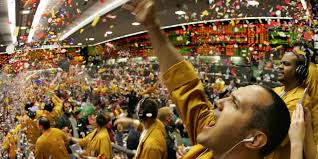The Stock Market’s Record Bull Run Could End Soon. Here’s How

The S&P 500 Index closed the week at an all-time high, capping what by some measurements say is the longest bull market since World War II. And with a growing economy and rising earnings at many corporations, the mood in the stock market is bright enough to keep stock prices rising further.
But all bull runs must come to an end. And with the bull market currently in its tenth year, some analysts expect it to be a matter of time before stock prices begin to contract. Here are some things that could turn the bull into a bear.
First, the economy could tip into a recession, defined as two straight quarters of negative growth. While the U.S. GDP rose by 4.1% in the second quarter of 2018, the fastest growth in nearly four years, one third of economists surveyed by Reuters expect the U.S. economy to move into a recession in the coming two years.
Rising interest rates are another threat to the stock market down the road. The Federal Reserve has raised interest rates five times since President Trump took office in January 2017. In June, when the Fed last raised interest rates in June, it signaled that it could raise them two more times this year.
Trump has publicly expressed his displeasure at the higher interest rates, but the Fed may decide they are necessary to keep inflation in check. Fed Chair Jerome Powell said in a speech at the Jackson Hole Symposium Friday that he sees “further, gradual” raises in rates, but a rise in inflation could prompt more aggressive action.
Two common gauges that investors follow to anticipate the end to a bull market could also signal the end is nigh. One is an inverted yield curve—which tracks the difference between longer-term and short-term rates. If long-term rates fall below short-term rates, it can signal a recession. The inverted yield curve has correctly predicted the last seven recessions.
The other metric to watch is the Leading Economic Index, which tracks forward-looking data like weekly hours worked and construction permits. The index is currently growing at around 5% annually, but a slowdown could provide a warning that the strong economic growth is passing.
The S&P 500 closed up Friday up 0.6% at 2,874.69, above the high point it reached in January. It’s been 3,455 days since the stock market has been in a bear market—typically defined as a drop of at least 20% from a record high—making this the longest bull market in the post-war economy. Some market observers, however, dispute that assessment, as there are different ways to measure it.


